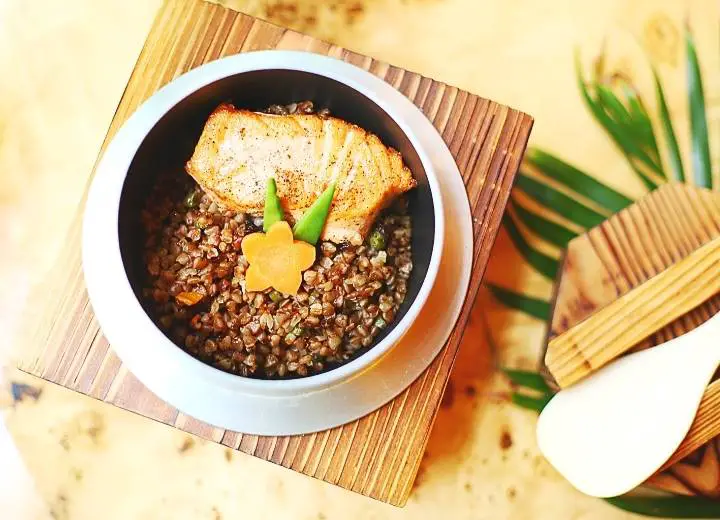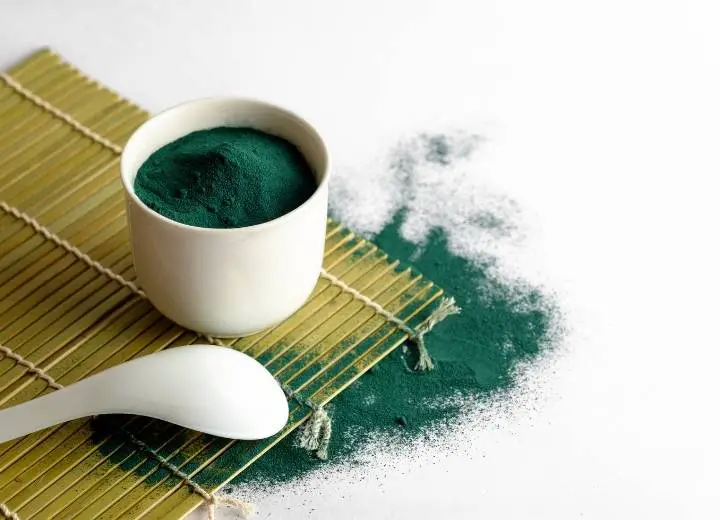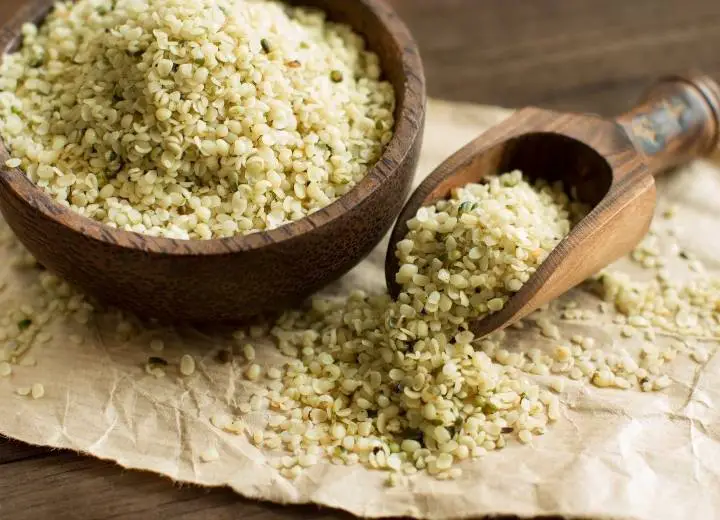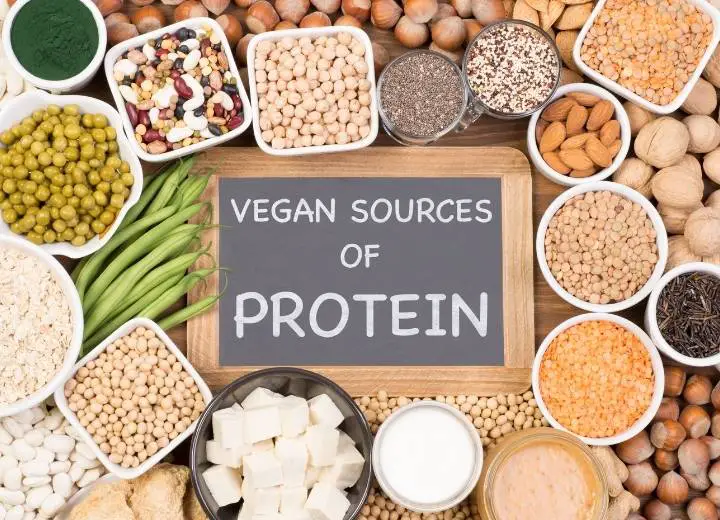As a vegan, you may be concerned about consuming enough protein. One surprising fact is, however, a large number of vegans take more than enough protein nutrients in their meals.
Vegans can eat exactly the right amount as everyone. Besides meat and animal sources, vegans can easily absorb protein from plant-based sources.
How to eat more protein as a vegan?
This is a list of 7 excellent sources that people can eat a lot of protein as a vegan:
- Quinoa
- Tofu, tempeh, and edamame
- Amaranth
- Buckwheat
- Ezekiel bread
- Spirulina
- Hemp seeds
#1. Quinoa
Quinoa is a type of grain that seems similar to couscous. Because it doesn’t grow from grasses, it’s seen as a pseudocereal and naturally gluten-free grain.
A cup (185 grams) of quinoa offers roughly 8 grams of protein. Besides being a full protein, quinoa offers more minerals like fiber, iron, magnesium, and zinc than other general grains.

You can replace rice with quinoa in almost all recipes. Quinoa can also be simmered in plant-based milk for protein-rich porridge in the morning.
#2. Tofu, tempeh, and edamame
Tofu, tempeh, and edamame are products made from soybeans. All of them are good plant-based sources of protein.
Three ounces (85 grams) of tofu offer about 8 grams of protein. It also provides roughly 15% of the Daily Value for calcium and some potassium, iron.
Tempeh is normally chewier and nuttier compared to tofu. A 3-ounce (85-gram) serving of tempeh contains 11 grams of protein ( also fiber, iron, potassium, and calcium).

Edamame beans are immature soybeans that are green and slightly sweet. A half-cup (85 grams) of edamame offers 8-gram protein with fiber, calcium, iron, and vitamin C.
#3. Amaranth
Once seen as the main food in some cultures such as Incan and Aztec, amaranth has evolved into a well-known gluten-free pseudocereal grain alternative.
It is a versatile food that can be used for some recipes such as porridge, granola bars or salads. Amaranth features a delicate, nutty taste and can retain its crunch even when it is cooked.

A cup (246-gram) of amaranth offers roughly 9 grams of protein. It is also a great source of manganese (an important mineral for brain health), magnesium phosphorus, and iron.
#4. Buckwheat
While buckwheat is not as high in protein level as quinoa and amaranth, it is another pseudocereal grain providing an excellent source of protein.
With the nutty flavor, buckwheat can be used similarly to oatmeal or you can ground it into flour used in baking. In Japanese culture, buckwheat is most popularly used in noodles, also known as soba.

A cup (168-gram) of buckwheat groats offers about 6-gram amounts of protein. Food is also a great source of many other critical minerals, such as manganese, phosphorus, magnesium, copper, and iron.
#5. Ezekiel bread
The main ingredient of Ezekiel bread is sprouting whole grains. The others are legumes, namely wheat, barley, lentils, soybeans, millet, and spelt.
Two slices (68-gram) of Ezekiel bread have 8-gram quantities of protein.
Unlike almost all bread, the mixture of whole grains and legumes in the bread offers all nine critical amino acids.

Additionally, research suggests that sprouted grains and legumes pop up their amino acid level, typically the amount of the amino acid lysine.
To get an extra protein content, you can use the bread to make vegan BLT sandwiches with tempeh rather than bacon. You can also toast slices of Ezekiel bread and top them with peanut butter or chia seeds.
#6. Spirulina
Spirulina is cyanobacteria, a type of blue-green algae. That’s a well-known supplement that is essential on vegan as well as vegetarian diets.
Although you can purchase spirulina in the form of tablets, it is suggested to buy spirulina powder. The reason is that it can be used as an ingredient in smoothies, granola bars, soups, and salads to boost nutrition.

One tablespoon (7-gram) of dried blue-green spirulina offers 4-gram amounts of protein.
In addition, spirulina is high in antioxidants and an excellent source of several B vitamins, copper, and also iron.
#7. Hemp seeds
Derived from the Cannabis sativa plant, hemp seeds are in the same species as marijuana. Yet, hemp seeds contain only very small quantities of tetrahydrocannabinol (THC), called the psychoactive factor of marijuana.
Consequently, hemp seeds are impossible to have enough THC to trigger high feelings or any psychoactive impacts related to marijuana.

Still, some concerns are raised from the fact that hemp seeds can get poisoned with TCH from other parts of the Cannabis sativa plant in the harvesting or storing process. Then, it’s vital to buy these seeds from trusted brands that have a test for THC.
The inside edible white of the hemp seed is seen as a hemp heart and extremely nutritious.
Besides protein, the hemp heart is especially rich in the necessary fatty acids including linoleic acid (omega-6) and alpha-linolenic acid (omega-3).
Three tablespoons (30-gram) of raw and hulled hemp seeds contain 10-gram content of protein with 15% of the DV for iron. They are also a great source of phosphorus, magnesium, potassium, and zinc.
The function of protein in the body
Protein plays an essential role in our health. It accounts for approximately 17% of the body’s weight. It is also the central part of the muscle, skin, internal organs, particularly the heart, brain, as well as the eye, hair, and nail.
The immune system needs protein to help create antibodies that can help to prevent infections. Protein is also the main part of blood glucose regulation, lipid metabolism, and energy function.
In fact, protein foods include 22 naturally occurring amino acids. They are the blocks that build up protein. Nine of these are critical amino acids that you must take from food (histidine, isoleucine, leucine, lysine, methionine, phenylalanine, threonine, tryptophan, and valine) since the body cannot create by itself.
Furthermore, protein is a great source of various vitamins and minerals like zinc and B vitamins. For almost all vegans, it’s vital to note that all these amino acids should be included in the vegan diet to ensure optimum nutrition.
The key to having an adequate quantity of protein, and all the essential amino acids, is the combination of various grains, different vegetables with pulses. For instance, you can combine beans with rice or set tofu with broccoli.
Variety is a guide when it comes to becoming a vegan. So do not use substitute products like vegan cheese to make up for any protein deficiency. It is given that products like vegan cheese are actually processed foods and provide a little health benefit.
Daily protein intake requirements
The Recommended Dietary Allowance RDA suggests that everyone should get 0.8 grams of protein for 1 kilogram. In other words, it is about 0.36 grams of protein for 1 pound of body weight. The recommendation covers a universal safety factor for almost all people.
Surprisingly, the digestion of plant proteins is relatively different from animal proteins. As a result, it comes with an amount of 0.9 grams of plant protein for every kilogram of body weight (about 0.41 grams protein per pound).
According to some nutrition experts, approximately 10% of calories for a vegan come from protein.
If you take some investigations into the food of vegans, it is typically found that about 10-12% of calories are derived from protein. This phenomenon is significantly different from the protein consumption of non-vegans, which is about 14-18% of calories.
The potential risk of high protein consumption
There is a small change between recommendations of protein intake in various nations. Some opinions suggest that, though, in the case of protein, more protein than the RDA is not always better.
Therefore, high consumption of protein does not appear to create health advantages for most people. Diets which feature high protein quantities are likely to even pop up the risk of osteoporosis and kidney disease.
Yet, it is especially involved in diets that are high in animal proteins (dairy and red or processed meats as an example).
However, some people think that a large protein intake is not so bad for health.
Long-term consumption of large amounts of protein was once believed to make a contribution to osteoporosis (bone loss) and kidney dysfunction. Still, studies currently propose that there is insufficient evidence of this side effect in healthy people.
A high protein meal may be an issue for those with an available condition or kidney failure. Yet, for healthy individuals, even the elderly, higher protein consumption could typically be beneficial for health by helping to avoid muscle loss.
Recently, not so much research has been implemented into some risks related to high protein vegan diets. Even so, a consistent factor of vegan diets is to make sure that there is a variety of food. You also should keep attention to vitamin and mineral demands, particularly in pregnancy.
Keep in mind to take a test of health condition as well as get recommendations from your doctor to have a balanced vegan diet, typically the right intake of protein.
The bottom line
In spite of some concerns about the ability to get an adequate protein content on a vegan diet, you can eat high protein as a vegan with a lot of high protein, plant-based foods available.
Moreover, a variety of these plant-based foods even offer all nine critical amino acids, and then they are referred to as complete proteins.


